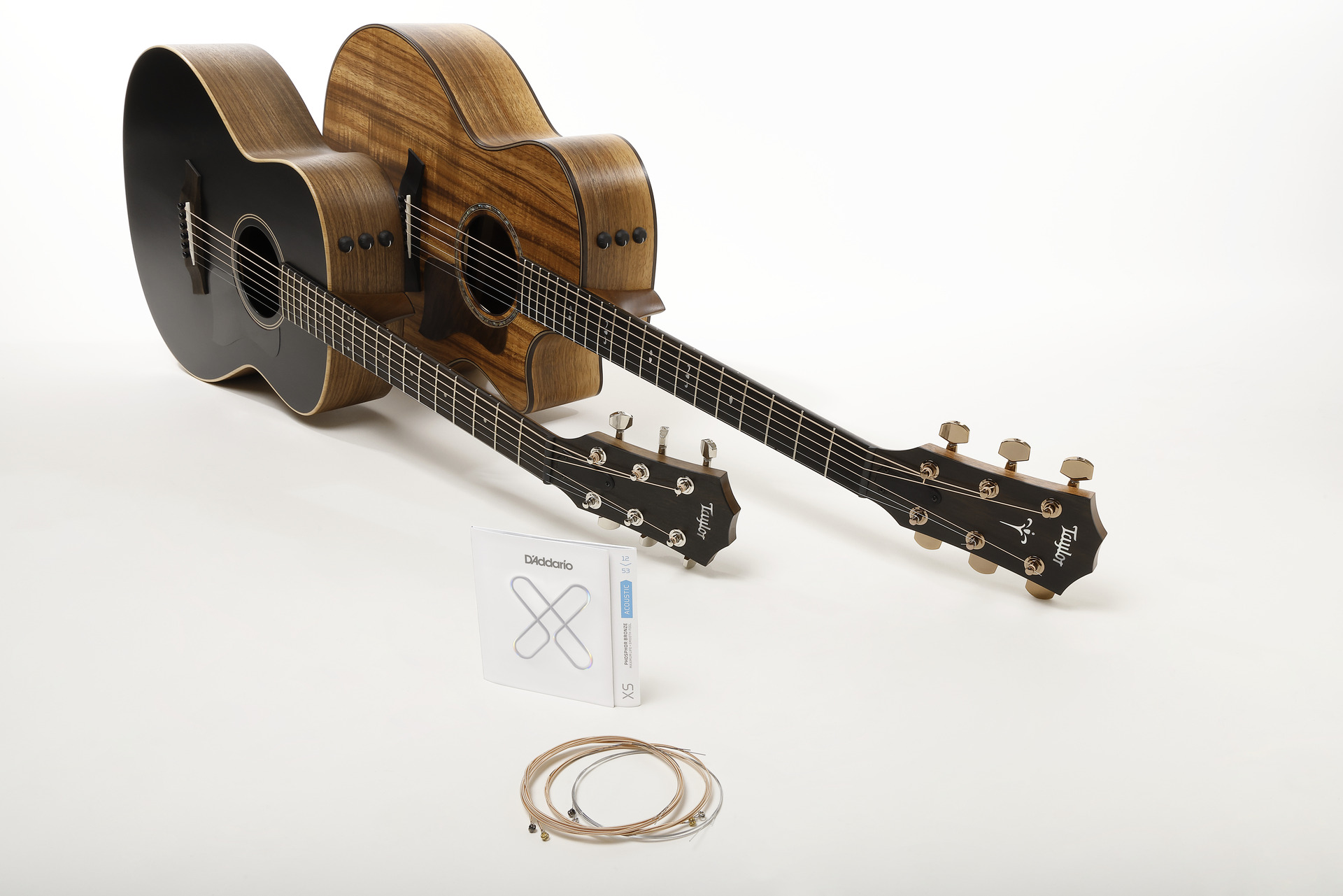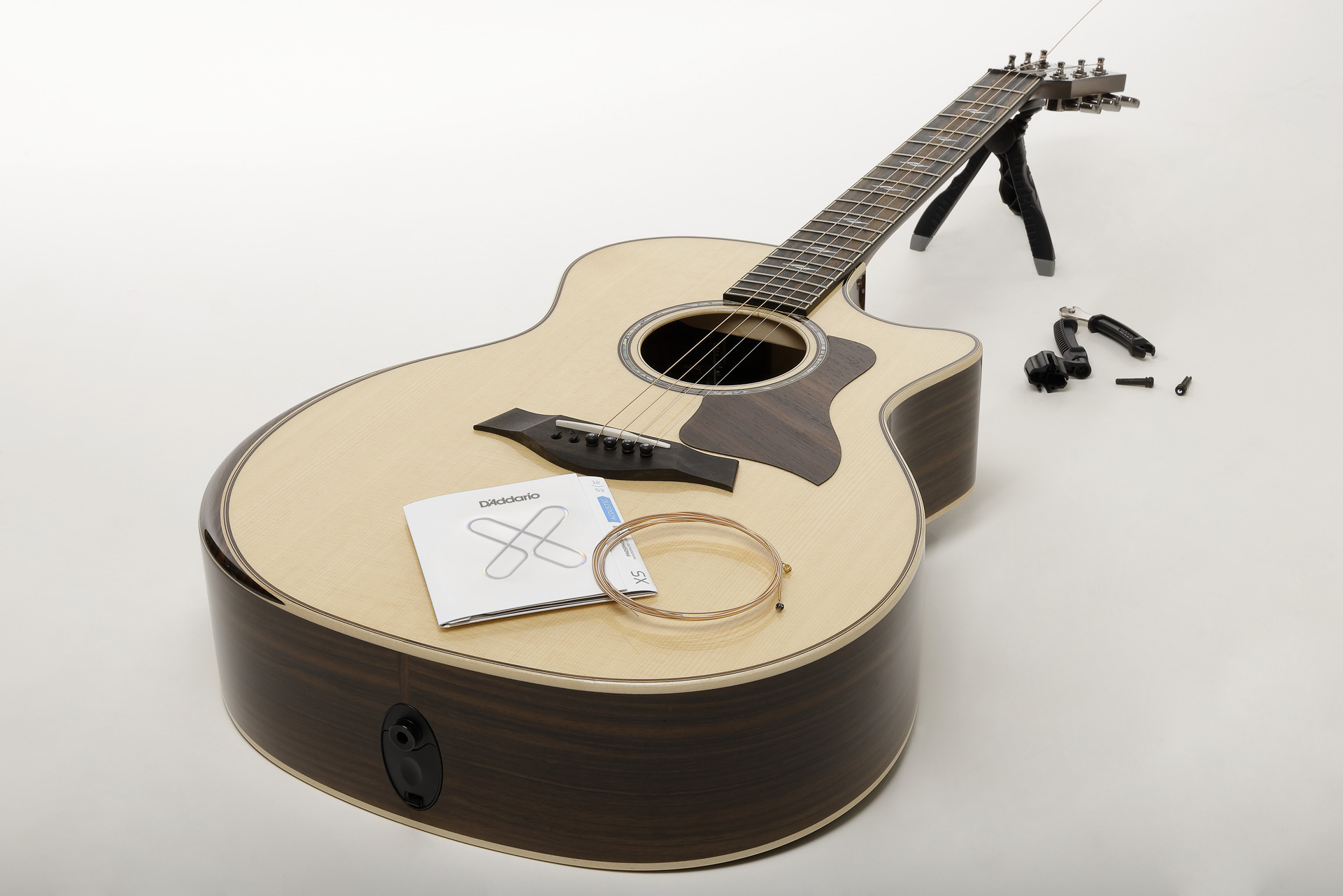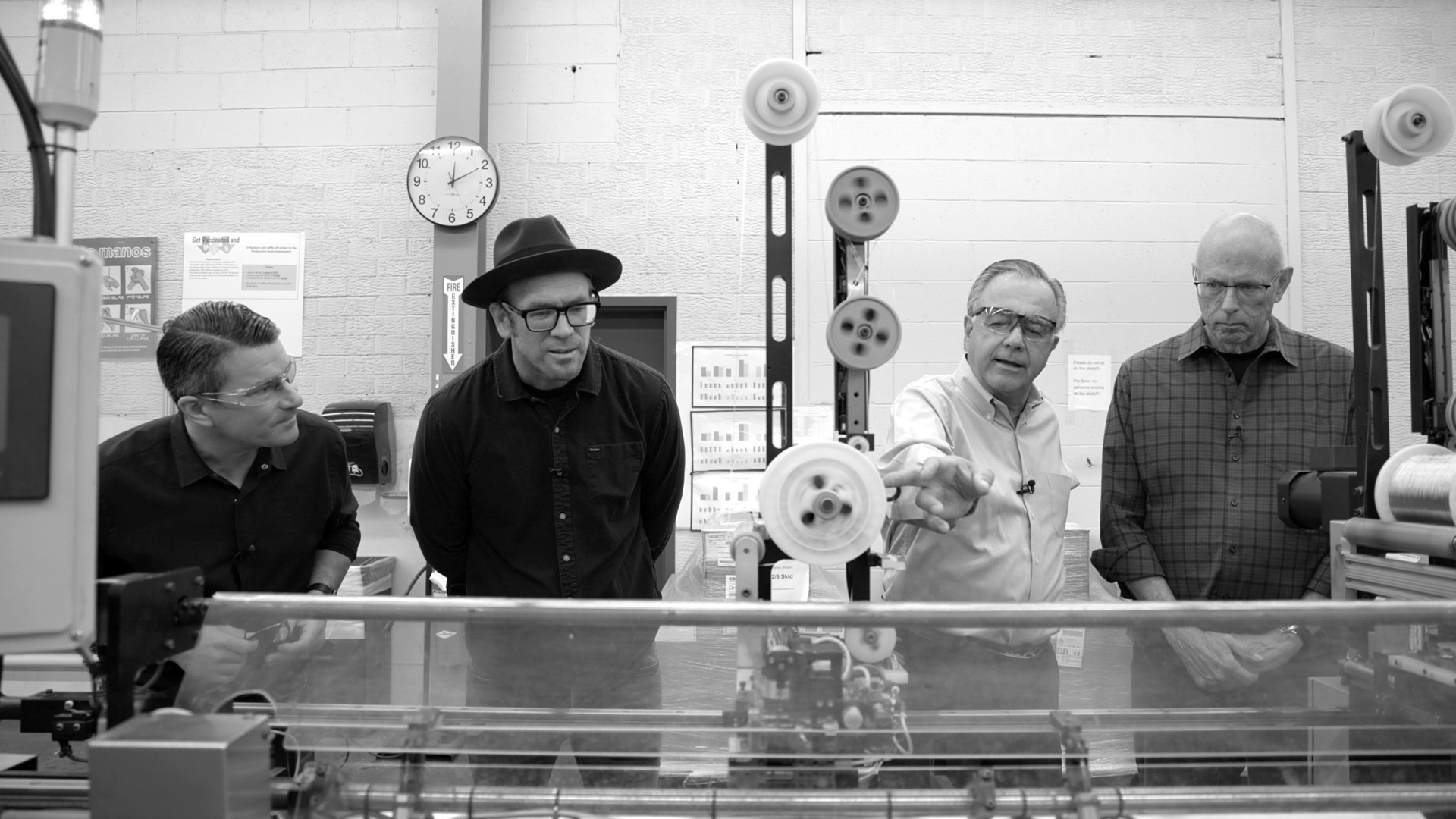After 24 years, we’ve decided it’s time to change our strings.
We’re happy to share that we’ve begun installing D’Addario’s premium XS coated phosphor bronze strings on our acoustic steel-string models. As of this summer, most of Taylor’s U.S.-built models are being strung with the XS coated strings (along with XS coated nickel electric strings on our T5z models), and we’ve begun that transition on our Mexico-made guitars (Baby Taylor through 200 Deluxe Series).
The decision came from Taylor’s chief guitar designer, Andy Powers, who favors the sound, feel, durability, consistency and performance of the XS coated strings in tandem with his latest guitar designs and other models within the Taylor lineup.
“We’re excited for this new chapter of partnership with D’Addario,” Andy says. “The XS strings are really consistent and produce a great response. By working to optimize the musicality of our guitars, we want to help musicians express themselves to the fullest.”
The move builds on a longstanding association between Taylor and D’Addario, whose steel-string sets we used for many years, and whose nylon strings we’ve used since the introduction of our nylon-string guitars in 2003. There’s always been a kinship between the two companies —reflecting a shared passion for innovation, manufacturing excellence and sustainability leadership.
“I feel like we’re really on the same wavelength,” says D’Addario founder, Chairman of the Board and Chief Innovation Officer Jim D’Addario of the two companies. “We really run our businesses the same way.”
Performance Consistency
Throughout his tenure at Taylor, Andy has talked about the different ingredients that factor into a guitar designer’s recipe for a guitar — like the choice of tonewoods, the body dimensions, the internal bracing architecture — and the distinctive ways they interact to shape a guitar model’s sonic identity.
Another essential ingredient is the guitar strings, which literally set the guitar in motion. By design, the strings should optimize the musical output of the guitar. And for Andy, there are clear musical metrics he looks for in a string’s performance: pitch accuracy, dynamic range, sustain and feel.
Of particular importance, he says, is the performance consistency across a set of strings.
“More than anything, what I always look for is whether the strings all behave in the same kind of way,” he says. “As a guitar maker, I want the exact same character from one string to the next. Otherwise, you can ruin everything about the guitar.”
That desire for consistency across each string set is amplified by the scale of Taylor’s production — in the range of 200,000 guitars each year. With our manufacturing sophistication, we’ve been able to bring an extraordinary level of consistency to the build quality of our instruments. Similarly, D’Addario has achieved impressive consistency through its proprietary string-making technology and precision manufacturing processes, which allow them to produce 800,000 strings a day.
The Value of Coated Strings
There’s another important consideration with strings: their performance longevity, especially in a store environment, where a guitar might be played by many customers before it finds a permanent home. No matter how well-crafted a guitar might be, dirty or dead strings will compromise the guitar’s tonal response, potentially causing it to languish in a store.
That’s one reason why Taylor adopted Elixir strings for our steel-string acoustics back in 1999. The company was the first string maker to introduce a coated guitar string, and that revolutionary technology proved to extend the string life considerably in a high-traffic retail setting.
Collaborating with D’Addario to Make the GS Mini Bass
A great example of the innovative spirit that connects Taylor and D’Addario is the development of our award-winning GS Mini Bass, launched in 2017. Andy had been exploring ways to take the compact proportions of the popular GS Mini and make a small, ergonomically friendly acoustic bass — a radical notion given that the scale length was about 10 inches shorter than a typical bass. A traditional string set simply wouldn’t be able to make accurate notes at that string scale length.
Andy pitched his idea to D’Addario’s string engineering team, who proved to be hugely instrumental as a development partner. For more than a year, D’Addario’s team worked with Andy to develop a custom string formulation that would allow the bass to function. In the end, the collaboration yielded a unique solution — a nylon-core string overwound with a traditional phosphor bronze wrap wire.
“That combination worked great,” Andy says. “Without those strings, I’m not sure this instrument would have been possible.”
Since the bass’s launch in 2017, Andy has stayed connected with the D’Addario team, both as he pursued his new guitar design recipes and as D’Addario pushed forward with their own string R&D projects, on their way to releasing their premium XS coated strings in 2021. Andy had the opportunity to beta test some of the XS string set prototypes along the way and offered feedback on how they performed with his V-Class bracing designs and other new models he was developing like the Taylor Grand Pacific.
Jim D’Addario remembers the impact of a complimentary note Andy sent after testing one particular iteration of XS strings.
“When that email about the testing sample went around the office, there was a bit of celebrating,” he shares.
XS String Innovation
Developing and refining the technology to produce the coating for the XS strings, says Jim D’Addario, took his engineering team more than four and a half years.
“We had to develop our own film that we would treat, impregnate and slit, and put it on spools,” he says. “We had to make special winding machines to wind that thin ribbon — it’s 1/30th the thickness of Saran wrap. And we came up with what I think is the best coated string on the market because it’s long-lasting and you can’t tell it’s coated [in terms of] the sound. It’s almost identical to an uncoated string. It’s one of the products we make that I’m proudest of.”
For Andy, the final version of the strings checked all the boxes he was looking for in advancing his designs.
“The [XS] string moves more in the way that it should to make an accurate note,” he says. “That was a big step for me. It just feels more musical. It’s a beautiful feeling. A great response. Really consistent. It’s got all the metrics that I could say make something musical: the dynamic range, the pitch accuracy, the feel, the sustain… And then you learn how it’s made and it starts to make sense.”
Anatomy of a String: A Closer Look at D’Addario’s XS String Technology
- Ultra-thin coating: Ten times thinner than a human hair, D’Addario’s proprietary coating technology offers the highest degree protection from contaminants to maximize the string life. It incorporates a super-thin film coating on the wound strings and a unique polymer treatment on the plain steel strings.
- Hex core construction: The hexagonal core wire enables the wrap wire to grip in a way that improves the dimensional stability and durability and produces precise intonation.
- Fusion Twist technology: According to D’Addario’s team, this construction technique optimizes the tuning stability and improves the break strength for the plain strings.
- Premium high-carbon steel core wire: D’Addario touts its in-house steel processing capability to improve tuning stability and break resistance.
- In-house wire drawing: D’Addario’s proprietary wire drawing machines and processes give them precise control over the quality and consistency of their wire.
Taylor x D’Addario: The Conversation
Earlier this year, in preparation for the launch of our string partnership, Bob Taylor and Andy Powers visited D’Addario’s headquarters in Farmingdale, Long Island, New York, to participate in a conversation with Jim D’Addario. Fretboard Journal publisher Jason Verlinde moderated the chat, which was captured on video, as Bob, Andy and Jim reflected on their relationship, their respect for each other, the philosophies of their respective companies, and why they make compatible business partners.
“Jim [D’Addario] and I have always had a common love for industrializing things,” Bob points out. “Making machines, making high-quality things. I’m highly respectful of Jim’s abilities.”
What’s made D’Addario successful, Jim says, is curiosity and a kind of persistence that’s become ingrained in their culture.
“If I think we’ve got a good idea and if it’s not working out, I stick to it until we get it to work, and that’s really made us what we are. We are always looking for ways to do it better.”
Persistence in pursuit of guitar innovation underscores the symbiotic nature of both company cultures and speaks to the parallel paths each has traveled over the past half century.
Although Andy came to Taylor later (2010), he has known Jim for a long time and has great respect for what Jim and D’Addario have accomplished.
“When I met Jim, I found a kindred spirit,” Andy says. “It’s the guitar maker in us that wants to be standing alongside the string maker in them.”
Watch the conversation in its entirety below.
The conversation about the strings calls to mind comments Andy made about the importance of feel and response in a 2022 interview in Wood&Steel.
“There are differences beyond sonority, because we’re not talking solely about what you’re hearing, but what the guitar makes you feel,” he says. “This isn’t even directly speaking to how far the strings are from the fretboard, their tension or scale length — setup qualities that are measurable. It’s about the back-and-forth communication you experience when you’re playing a certain guitar. When there’s something about the combination of the sound that comes out of it, the feel of those strings under your fingertips, the resiliency and flexibility, the touch sensitivity — the combination of all the tactile elements and the resulting sound that comes from them — that informs how a player interacts with the guitar.”
Reducing String Waste and Launching a String Recycling Program
An important shared value between Taylor and D’Addario is a commitment to environmental stewardship and socially responsible business practices. One common denominator is the desire to use modern manufacturing methods to create efficiencies and reduce waste. As part of our new string partnership, Taylor and D’Addario have been discussing ways for D’Addario to make strings that are closer to the actual length needed, especially for guitars with shorter scale lengths like the GS Mini, to minimize the waste of excess string material.
Another obvious example of D’Addario minimizing its environmental impact is by making coated strings that greatly extend the performance life, meaning that players won’t have to change their strings as often. And to reduce the waste associated with used strings, D’Addario has invested considerable resources into a pioneering string recycling program called Playback, created in partnership with TerraCycle, a company that specializes in developing solutions for hard-to-recycle products.
Currently administered in the continental U.S., the program enables players to recycle their used guitar and orchestral strings (steel and nylon) by dropping them off in a D’Addario/TerraCycle recycling collection bin at a location near them. Most recycling bins are located in participating music stores. (You can find a recycling location near you here.) Metal strings are melted down and smelted into new metal alloys; nylon strings are recycled into industrial plastic applications.
As part of our string partnership, Taylor is proud to join the program and encourage Taylor owners to recycle their strings. On our campus in El Cajon, California, we’ve set up collection bins for our own internal use in strategic areas of the factory (such as our Repair department). We’ve also become a public string recycling drop-off center listed on the D’Addario website, with a recycling bin located in our Visitor Center.
Through the Playback program, individuals also have the option of shipping their used strings to be recycled by creating a free Players Circle account on the D’Addario website. (A shipping label can be downloaded via the account.) The qualifier is that, in order to reduce the carbon footprint associated with shipping strings, shipments must weigh a minimum of five pounds.
Given that threshold, the folks at D’Addario suggest that interested individuals could collect used strings from other players (friends, bandmates, music classmates) in order to meet the weight requirement and ship larger quantities more efficiently. (Terracycle calls this “brigade work.”) An additional incentive is that the individual will accrue points through their Players Circle account that can be applied as currency toward eligible D’Addario products.
Between heirloom-quality guitars and premium, long-lasting strings that can eventually be recycled, players can feel better than ever about playing a Taylor.



